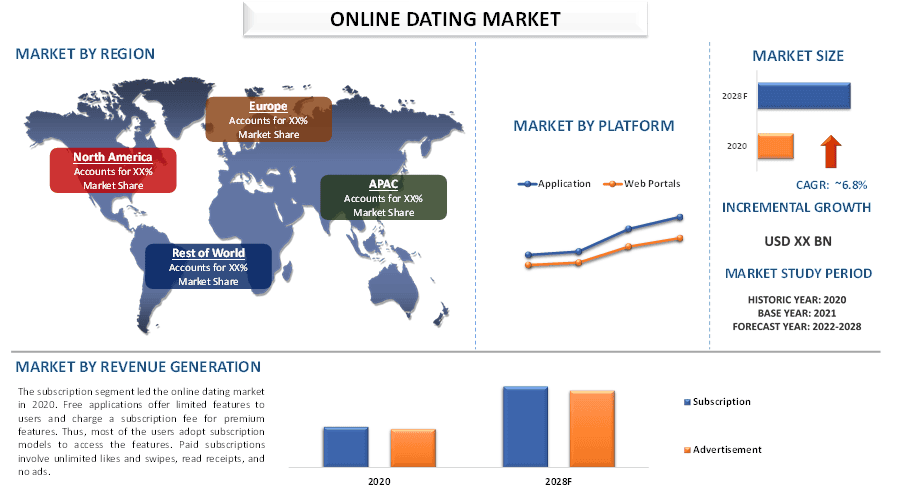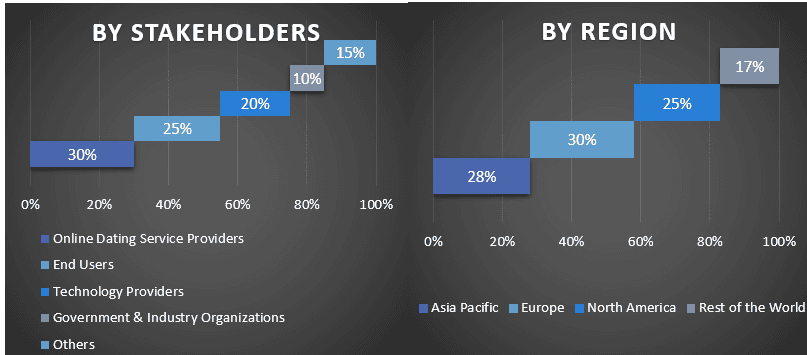- Home
- About Us
- Industry
- Services
- Reading
- Contact Us
Online Dating Market: Current Analysis and Forecast (2022-2028)
Emphasis on Platform (Application and Web Portals); Revenue Generation (Subscription and Advertisement); and Region/Country

Global Online Dating Market is expected to grow at a significant rate of around 6.8% during the forecast period 2022-2028. Online dating—also referred to as Internet dating, virtual dating, or mobile app dating—is a relatively new practice in which individuals utilize the internet to look for and communicate with potential romantic or sexual partners. The popularity of online dating applications, rising smartphone usage, and increased internet penetration are all likely to contribute to the online dating market growth. However, it is anticipated that rising online fraud and data breaches caused by dating apps will impede industry expansion.
Bumble, Coffee Meets Bagel, Cupid Media Pty Ltd, eharmony Inc., EliteSingles, Match Group (Tinder), rsvp.com.au Pty Ltd, Spark Networks SE, The League, and The Meet Group are some of the key players in the online dating market. The market is diversified with a large number of global and regional market players. The market players are following both organic and inorganic growth strategies to sustain the competitive edge. For instance, in March 2020, Tinder Inc. announced that the company recorded more than 3 billion swipes led to increased growth of online dating apps. Similarly, in February 2020, the Dating app Plenty of Fish announced the industry’s first Member Pod, an advisory council comprised of real users. The main idea or goal of the Member Pod is to obtain feedback from a diverse range of people to foster innovation and development and enhance the Plenty of Fish experience.
Insights Presented in the Report
“Amongst platform, software online dating category is anticipated to witness higher CAGR during the forecast period”
Based on the platform, the market is segmented into application and web portals. The application segment led the online dating market with a larger revenue share of more than 80% in 2021. The market share was boosted by the rising global popularity of apps like Tinder, Bumble, Badoo, and others. For instance, the average Tinder user base increased to 10.4 million in 2020 from 7.9 million in 2018. Therefore, the increasing number of subscribers demonstrates the growing popularity of such online dating apps, which further contributed to the highest market share.
“Amongst revenue generation, the subscription segment accounted for the largest revenue share in 2020”
Based on revenue generation, the market is divided into subscription and advertisement. The subscription segment accounted for the largest revenue share of more than 62% in 2020 and is also anticipated to continue its dominance during the forecast period (2022-2028). Applications that are available for free have a limited feature set and require a subscription to access premium features. As a result, the majority of users use subscription-based access to the features. Unlimited likes and swipes, no advertisements, and read receipts are included in paid subscriptions.
“North America to hold a significant share in the online dating market”
North America dominated the online dating market with a share of more than 35% in 2020. This can be attributed to the region having reputable online dating services. Additionally, the presence of leading market players in the region is also expected to contribute to market growth, such as, EliteSingles, Spark Networks, Inc., Bumble Inc., and eHarmony, Inc., among others.
Reasons to buy this report:
- The study includes market sizing and forecasting analysis validated by authenticated key industry experts.
- The report presents a quick review of overall industry performance at one glance.
- The report covers an in-depth analysis of prominent industry peers with a primary focus on key business financials, product portfolio, expansion strategies, and recent developments.
- Detailed examination of drivers, restraints, key trends, and opportunities prevailing in the industry.
- The study comprehensively covers the market across different segments.
- Deep dive regional and country-level analysis of the industry.
Customization Options:
The global online dating market can further be customized as per the requirement or any other market segment. Besides this, UMI understands that you may have your own business needs, hence feel free to connect with us to get a report that completely suits your requirements.
Table of Content
Research Methodology for the Online Dating Market Analysis (2022-2028)
Analyzing the historical market, estimating the current market, and forecasting the future market of the global online dating market were the three major steps undertaken to create and analyze the adoption of online dating in major regions globally. Exhaustive secondary research was conducted to collect the historical market numbers and estimate the current market size. Secondly, to validate these insights, numerous findings and assumptions were taken into consideration. Moreover, exhaustive primary interviews were also conducted, with industry experts across the value chain of the global online dating market. Post assumption and validation of market numbers through primary interviews, we employed a top-down/bottom-up approach to forecasting the complete market size. Thereafter, market breakdown and data triangulation methods were adopted to estimate and analyze the market size of segments and sub-segments of the industry pertains to. Detailed methodology is explained below:
Analysis of Historical Market Size
Step 1: In-Depth Study of Secondary Sources:
Detail secondary study was conducted to obtain the historical market size of the online dating market through company internal sources such as annual reports & financial statements, performance presentations, press releases, etc., and external sources including journals, news & articles, government publications, competitor publications, sector reports, third-party database, and other credible publications.
Step 2: Market Segmentation:
After obtaining the historical market size of the online dating market, we conducted a detailed secondary analysis to gather historical market insights and share for different segments & sub-segments for major regions. Major segments are included in the report as component, protocol, and application. Further country-level analyses were conducted to evaluate the overall adoption of testing models in that region.
Step 3: Factor Analysis:
After acquiring the historical market size of different segments and sub-segments, we conducted a detailed factor analysis to estimate the current market size of the online dating market. Further, we conducted factor analysis using dependent and independent variables such as platforms, sources of revenue generation, and subscription models of online dating. A thorough analysis was conducted for demand and supply-side scenarios considering top partnerships, mergers and acquisitions, business expansion, and product launches in the online dating market across the globe.
Current Market Size Estimate & Forecast
Current Market Sizing: Based on actionable insights from the above 3 steps, we arrived at the current market size, key players in the global online dating market, and market shares of the segments. All the required percentage shares split, and market breakdowns were determined using the above-mentioned secondary approach and were verified through primary interviews.
Estimation & Forecasting: For market estimation and forecast, weights were assigned to different factors including drivers & trends, restraints, and opportunities available for the stakeholders. After analyzing these factors, relevant forecasting techniques i.e., the top-down/bottom-up approach were applied to arrive at the market forecast for 2028 for different segments and sub-segments across the major markets globally. The research methodology adopted to estimate the market size encompasses:
- The industry’s market size, in terms of revenue (USD) and the adoption rate of online dating across the major markets domestically
- All percentage shares, splits, and breakdowns of market segments and sub-segments
- Key players in the global online dating market in terms of products offered. Also, the growth strategies adopted by these players to compete in the fast-growing market
Market Size and Share Validation
Primary Research: In-depth interviews were conducted with the Key Opinion Leaders (KOLs) including Top Level Executives (CXO/VPs, Sales Head, Marketing Head, Operational Head, Regional Head, Country Head, etc.) across major regions. Primary research findings were then summarized, and statistical analysis was performed to prove the stated hypothesis. Inputs from primary research were consolidated with secondary findings, hence turning information into actionable insights.
Split of Primary Participants in Different Regions

Market Engineering
The data triangulation technique was employed to complete the overall market estimation and to arrive at precise statistical numbers for each segment and sub-segment of the global online dating market. Data was split into several segments & sub-segments post studying various parameters and trends in the areas of the platform and revenue generation in the global online dating market.
The main objective of the Global Online Dating Market Study
The current & future market trends of the global online dating market were pinpointed in the study. Investors can gain strategic insights to base their discretion for investments on the qualitative and quantitative analysis performed in the study. Current and future market trends determined the overall attractiveness of the market at a regional level, providing a platform for the industrial participant to exploit the untapped market to benefit from a first-mover advantage. Other quantitative goals of the studies include:
- Analyze the current and forecast market size of the online dating market in terms of value (USD). Also, analyze the current and forecast market size of different segments and sub-segments
- Segments in the study include areas of the platform and revenue generation.
- Define and analysis of the regulatory framework for the online dating
- Analyze the value chain involved with the presence of various intermediaries, along with analyzing customer and competitor behaviors of the industry.
- Analyze the current and forecast market size of the online dating market for the major region.
- Major countries of regions studied in the report include Asia Pacific, Europe, North America, and the Rest of the World.
- Company profiles of the online dating market and the growth strategies adopted by the market players to sustain in the fast-growing market
- Deep dive regional level analysis of the industry
Related Reports
Customers who bought this item also bought










